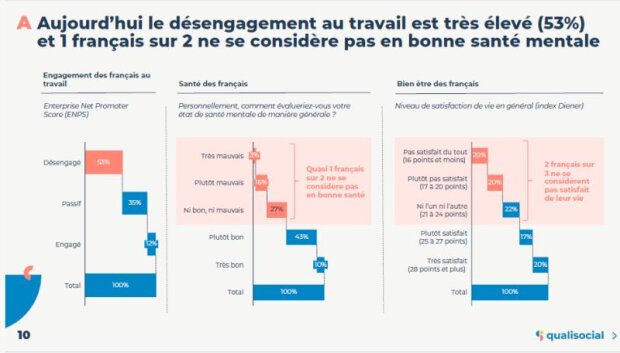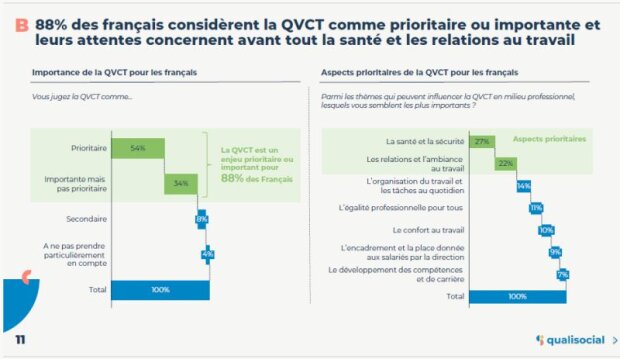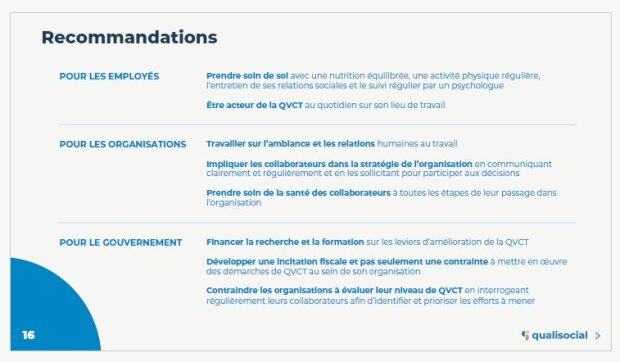THE
| Well being at work
The level of disengagement at work is high, according to Qualisocial's 2023 HRQoL survey. Organizations must take an active approach to promoting the mental health of their employees.

There HRQoL Or Quality of life and working conditions has a proven impact on:
- the health and well-being of the French;
- the commitment and performance of organizations and their employees.
The conclusions of Qualisocial's 2023 Major Survey prove to be relevant.
“QVCT is a representation of the factors that influence people’s perception of their quality of life,” declared Camy PuechCEO and founder of this consulting firm specializing in issues of psychosocial risks, quality of life and mental health at work.
The impact is becoming obvious, especially after the unprecedented period of Covid-19 which has caused physical and mental health problems for the French in general and for employees in particular.
“Companies have a societal commitment: to help individuals progress and make them feel good,” says Alexandre Stourbe, general director of Lab RH.
Beyond the transformation of the organization of work (with the rise of teleworking), the pandemic has underlined the importance of Quality of life and working conditions (QVCT), which has taken up the torch of Quality Life at Work (QVT).
A new name made official by the world of work with the signing of the ANI of December 9, 2020 on the prevention of professional risks in health and safety at work.
QVCT could be described as an approach aimed at improving the conditions in which employees carry out their work and their ability to express themselves and act on its content.
This theme is the subject of a dedicated week in France and organized from June 17 to 21 for 2024, under the aegis of ANACT (the National Agency for the Improvement of Working Conditions, a public administrative establishment placed under the supervision of the ministry in charge of labor).
Individual discomfort that affects motivation in business: towards a certain collective depression
By zooming in on Qualisocial's 2023 survey “Impact of QVCT on health, well-being, work engagement and organizational performance” published in January 2024, the junction between individual well-being and assessment of mental health in business is obvious.
It becomes difficult to isolate personal life and professional life given the interactions and overlaps between the two environments.
In November 2023, Qualisocial set up an unprecedented study to assess the state of QVCT in France and its impact on health, well-being, commitment to work and the economic performance of organizations.
Here are the two main trends.
Disengagement at work
The level of disengagement at work is high (53%) while conversely the rate of active involvement is low (12%).
- 35% declare themselves in a “passive” state;
- 46% of French people do not consider themselves to be in good mental health:
- 27% “neither good nor bad”,
- 16% “fairly bad”,
- 3% “very bad”;
- 62% do not consider themselves “satisfied with their life” with an almost equal proportion between “not satisfied at all”, “rather not satisfied” and “neither one nor the other”.

QVCT deemed essential
This is an almost unanimous observation:
- 88% of French people consider QVCT to be “priority” (54%) or “important” (34%) and their expectations primarily concern health and relationships at work.
- Among the predominant themes in QVCT are health and safety (27%) and relationships in the work environment (22%).

Qualisocial survey method
• 3,002 employees, constituting a representative sample of employees in the private and public sectors aged 18 and over, in France;
• Survey period: November 23 to 29, 2023;
• Survey carried out with a sample interviewed via the Internet using the CAWI (Computer assisted web interviews) system on the Ipsos online Access Panel;
• Quota method: Sex crossed by age, profession, region and urban category of the person interviewed.
Absenteeism, palpable unease
From another angle, the 8e Malakoff Humanis Barometer on absenteeism, published in June 2023, highlights the need to take greater account of QVCT in companies.
Here are some major trends deciphered:
- With 50% of employees in the private sector (all company sizes combined) stopped at least once a year, sickness absenteeism has reached its highest level since 2016.
- Absenteeism has increased by 9 points compared to 2016 (date of the first edition) and by 12 points since 2021.
- At the same time, the share of employees who consider themselves to be in good health has been declining for 3 years (68% in 2023 vs. 75% in 2020).
- Long stops for psychological disorders multiplied by two. All durations combined, ordinary illness remains the primary reason for sick leave. It is also the reason which shows the strongest growth this year (28% vs. 21% in 2022). Next come Covid (17%), psychological disorders (15%) and musculoskeletal disorders (13%).
- Psychological disorders constitute the main reason for long absences (more than 30 days). Long absences for psychological disorders have doubled in 3 years (32% vs 14% in 2020).
Malakoff Humanis Method
• Employee Health Barometer by Malakoff Humanis (2023 edition)
• Perception study conducted by Ipsos among 3,500 employees in the private sector via the Internet
• Survey period: March 17 to April 5, 2023
Which HRQoL indicators to remember?
6 areas of intervention defined by ANACT
In its QVCT survey – The Quality of Life and Working Conditions 2024 barometer, Qualisocial uses a QVCT approach structured around 6 areas of intervention defined by ANACT:
- professional dialogue and social dialogue;
- organization, content and execution of the work;
- Health at work ;
- skills and career paths;
- equality at work;
- the business project and management.
Qualisocial therefore draws inspiration from these areas of intervention to quantify the impact of QVT on the health, well-being, work engagement and economic performance of employees.
“To assess employee well-being, it is important to focus on what people are experiencing. In our opinion, the central subject is being able to work with a feeling of security. This notion of security covers remuneration, understanding with managers and colleagues, workload, variety of tasks, etc.,” underlines Camy Puech, CEO of Qualisocial.
How to monitor the HRQoL of private sector employees and public sector agents?
Between standards, labels, so-called reference tools and benchmarks… It is difficult to navigate the types of tools to assess QVCT.
Here are some approaches:
- ISO 26000 standard of international scope which aims to provide organizations with guidelines for social responsibility (CSR), but which goes far beyond the prism of QVCT in organizations;
- Labels that combine HR management, CSR and QVCT (B-CORP, LUCIE 26 000, Afnor Engagé RSE, etc.);
- Rankings and rankings of attractiveness of companies around the employer brand such as:
- Great Place to Work,
- Top Employers,
- the list of “50 preferred companies of students and young graduates” (Occurrence – Groupe Ifop – Epoka)
- ChooseMyCompany (HappyIndex®️AtWork ranking).
So, how to find your way? Here again, ANACT published in July 2023 a “Quality of life and working conditions framework” (available to members of the agency portal). It integrates 10 key ideas on QVCT with methodological advice to obtain a pulse of your organization, but also action plans to improve the health and well-being of your employees.
At the same time, a “Repository for the development of charters on QVCT in the public service” was introduced in June 2023, under the leadership of the General Directorate of Administration and Civil Service (DGAFP).
QVCT: from principles to operational commitment
There remains little doubt about the link between QVCT and employee engagement within teams and staff. But it is necessary to have prerequisite elements to properly approach the QVCT approach. And that starts with access to tools for detecting disengagement or even weak signals to follow.
“If we can anticipate complicated situations, we will be able to protect employees and give them motivation,” reports Geoffroy Verzat, co-founder of tealenamed after a French start-up which operates an application dedicated to the mental health of corporate employees (see the feedback in the QVCT file with its Batch client).
A look back at the recommendations of Qualisocial's 2023 Major Survey which divided the advice according to the targets concerned (employees, organization, government).

If we had to add one last piece of advice to score points in improving QVCT, it would be to carry out regular evaluations to monitor the evolution of the indicators over time and to find time and space for reflection to move forward collectively.
A calm and proactive approach to plan in the long term to avoid clashes in the event of a crisis triggered.
Key concepts and definitions: #Quality of Life at Work or QVT

